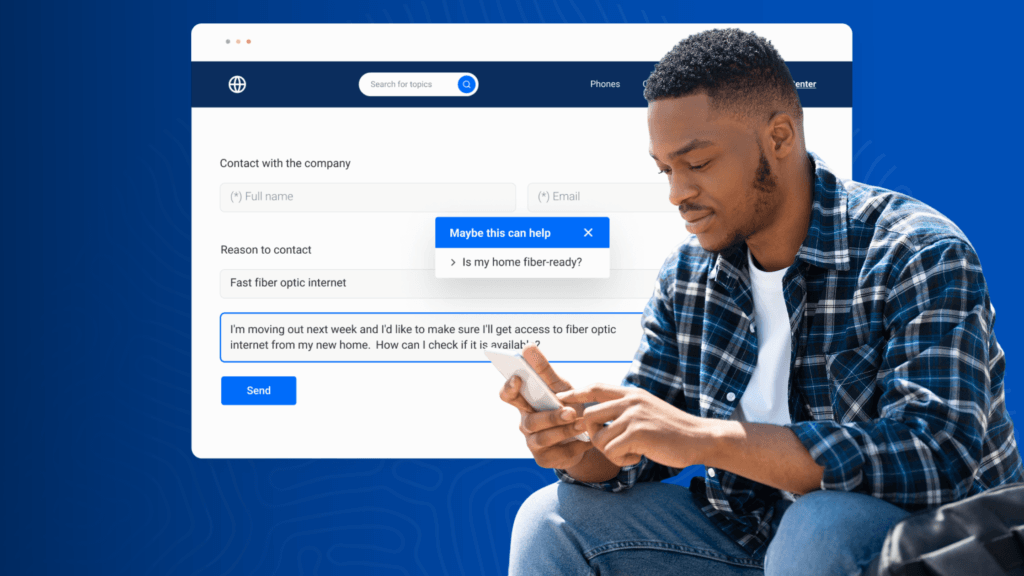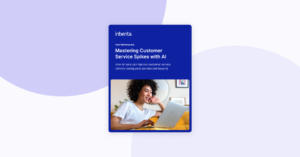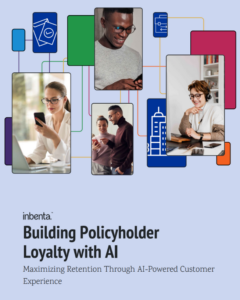Proactive support is an approach that requires helping customers before they need to contact your support team. There isn’t one specific tool or feature that carries out this task; instead, it’s an overall plan incorporated into your customer service strategy and technology.
Proactive support can be carried out by sending targeted messages via proactive chatbots or banners with specific content, FAQs or help articles, or facilitating user access to a knowledge base, anticipating their customer needs and providing answers even before they realize they have a question to ask.
What are the benefits of proactive support?

Proactive support is essential for several reasons. Instead of waiting for a customer to find a contact page, call or send an email seeking a response or guidance in their customer journey, proactive support finds the perfect time to provide assistance and the right tips to help customers when they visit a site. This brings numerous benefits such as:
Reduce your support inquiries
Proactive support helps identify issues and resolve them before they become bigger problems. Anticipating customer needs is important in a customer journey. According to Google and Econsultancy, almost 90% of successful businesses are sure that anticipating their customer needs and assisting these users along their journey is essential to fostering business growth. Additionally, by anticipating and resolving these problems, businesses can reduce the number of support tickets they receive and thus, associated costs.
Improve NPS score, customer satisfaction and retention
A Gartner survey found that proactive customer support provided a point increase in customer satisfaction metrics. These included Net Promoter Scores (NPS) and Customer Satisfaction Scores (CSAT). Moreover, 70% of customers have a favorable view of brands that provide proactive customer support. The higher the customer satisfaction, the better the customer retention, the word-of-mouth regarding your brand, and the more your brand will sell.
Build customer loyalty
With so much competition, it is crucial to step up your game regarding customer support. Over 60% of consumers would be willing to switch brands if the customer service didn’t match their expectations, so with so many alternatives available, it is a challenge to build and maintain customer loyalty if you do not recognize the importance of catering to customer needs from start to finish.
Proactive customer support can open opportunities to reach out to prospective and existing customers, encouraging them to switch to our brand or deepen your relationships with regular users.
Create brand ambassadors
Proactive customer support allows you to build loyalty and increase customer retention due to better services, assistance, availability and word-of-mouth recommendations. In fact, people are willing to talk about positive service experiences with their friends and families. We tend to tell up to three people, who in turn can recommend these services to their networks. Therefore, being proactive is an opportunity to not only attract or retain customers but to turn them into advocates of your brand.
Three examples of proactive support
Proactive support can be implemented in different ways and cater to diverse market needs. Here, we have selected three examples of different proactive support solutions and how they can or have helped businesses.
Help-sites with meaning-based suggestions
Many businesses look for capabilities that can respond to client requests on their website at any given time. We understand any project aiming at answering questions before the customer reaches the support is an example of practivity.
Therefore, one of the most widespread options nowadays are help sites like this one from Skrill.
Although this might seem pretty basic, there is something surprisingly different when we dig a bit deeper.
If we take a look at the query in the screenshot, we soon realize they went a step further in temps of suggesting results.
Usually, recommendations on help sites are based on keywords and look similar to this:
They take into account the words written and try to find queries or content that starts exactly like that, as well as suggest the most frequently asked questions.
However, we see how Skrill is using natural language processing to understand the meaning of requests (i.e. send money is understood as pay online or send crypto) and pull all content regarding the request, even if the results do not include the specific keyword the user typed in.
Another example of semantic search is the help site of Skyscanner.
If we ask about dynamic pricing we get suggestions as Why was the price different on Skyscanner to the one I was sent in my price alert?
But let’s take a deeper look at what this can mean for a business.
Here’s the French car insurer Direct Assurance. With a website that generates over 250k visits a month, Direct Assurance sought help to find a solution that could automatically answer their customer requests seven days a week while increasing their SEO traffic and managing inbound contacts.
To reach this objective, they integrated Inbenta’s Knowledge module, a help site and content manager running on a unique semantic search engine. Accessible on the website via the header or the Help section, the help content is optimized for SEO and delivers 24/7 answers to user requests via its automatic natural language processing capabilities.
The Inbenta Knowledge software also comes with an autocomplete feature and highlights the top 5 questions being asked by users on the website. With this, users can easily navigate and find any information they need with an easy-to-use interface.
The results? Increased customer satisfaction, a decrease in support inquiries and an increase in web usage. The help section receives nearly 15,000 queries a month and answers with a 70% correct rate. Unrelated to that, but still very interesting, Direct Assurance’s SEO also saw a dramatic increase, with 175 questions and answers appearing in position 0 on Google and attracting 15% of the website’s overall traffic.
Proactive chatbots
Proactive chatbots differ from reactive chatbots in that they do not wait for a customer to type a request. Rather than wait for the visitor to engage, proactive chatbots initiate a conversation to engage and persuade a user to carry out a specific task based on a series of behaviors.
These behaviors can be several, such as:
- Pages visited: depending on the pages a user visits, chatbots can recommend content, offers or actions that lead the user to convert.
- Time on page: interactions can be triggered depending on how long a user has been browsing on a page.
- Scrolling: depending on the stage of a page a user has scrolled down to, chatbots can be activated in the same way as a pop-up but in a less invasive manner. Chatbots can recommend similar content, products and discounts or facilitate processes and transactions.
- Shopping cart: Proactive chatbots can determine the number of items in a shopping basket or the total value of an order to offer discounts and offers to customers.
Inbenta’s Proactive chatbots can subsequently strengthen your brand image if used appropriately and not invasively. They also anticipate customer needs and help increase conversions.
Forms that anticipate and suggest answers
Proactive support can be leveraged:
- Before the user shows any behavior indicating he might need assistance
- Or when a user heads to a help site or a page including a contact form.
One interesting feature in the second case are content-recognizing forms.
What are those? These are forms including a text field where users can express their issues in natural language. Behind the scenes, the text introduced by the user is being analyzed by a processing engine that suggests content from the FAQs.
This results in a decrease in actual support request forms sent to agents, which helps reduce agent’s workload and avoid repetitive requests that could have been solved without human intervention.
Proactive chatbots can give brands a competitive edge
Customers are increasingly seeking brands that deliver standout customer service. Being proactive with your customer service can make a difference in creating a better experience for them.
Businesses that choose to deliver proactive customer service will find that customers will become more trustworthy and loyal. Proactivity can encourage customers to carry out actions that they may not have thought of doing and appreciate the help and engagement with the brands they are visiting.
Transform your customer experience here.











